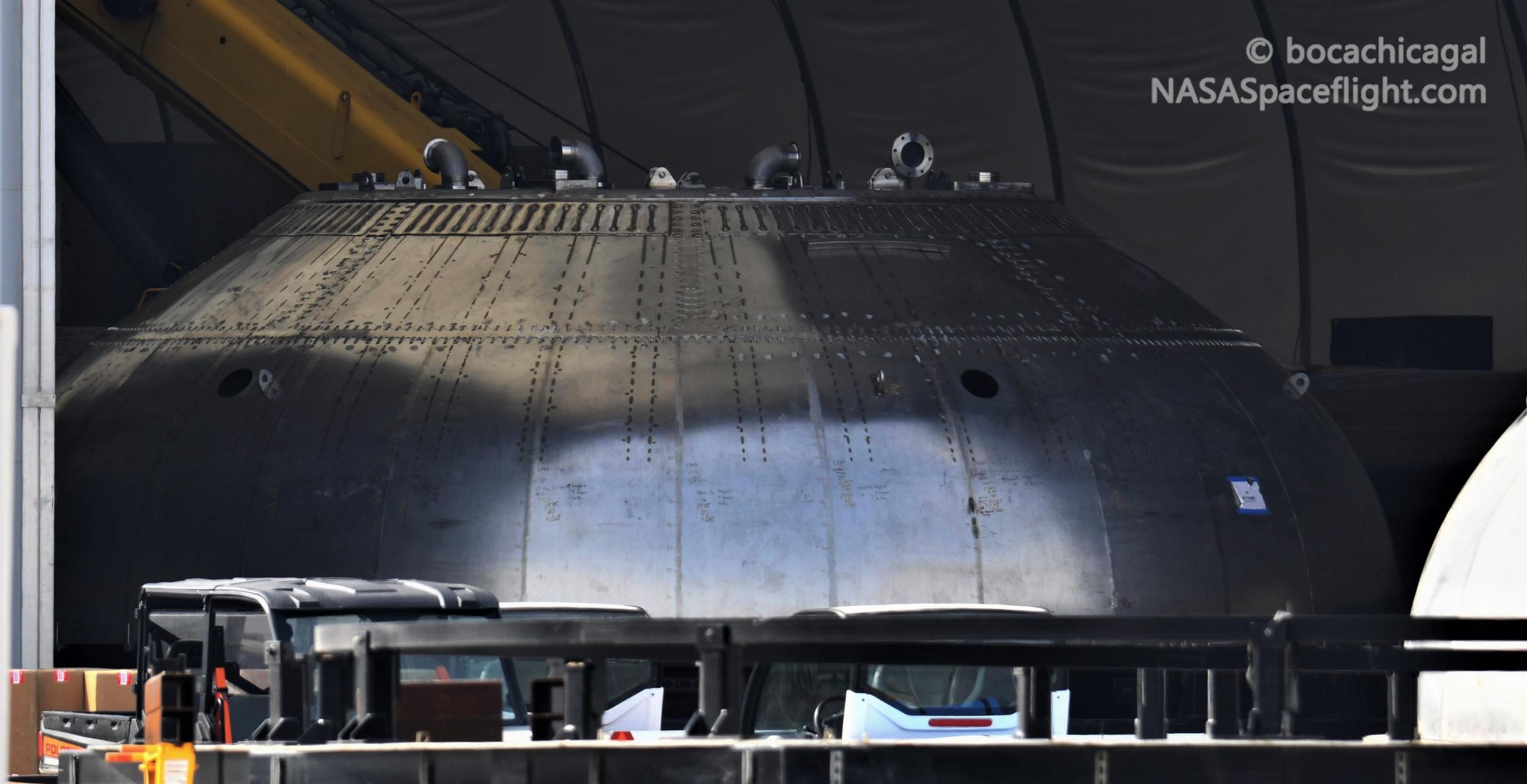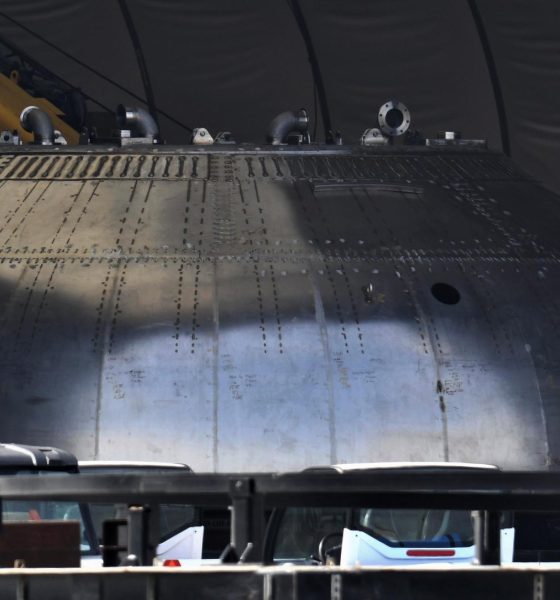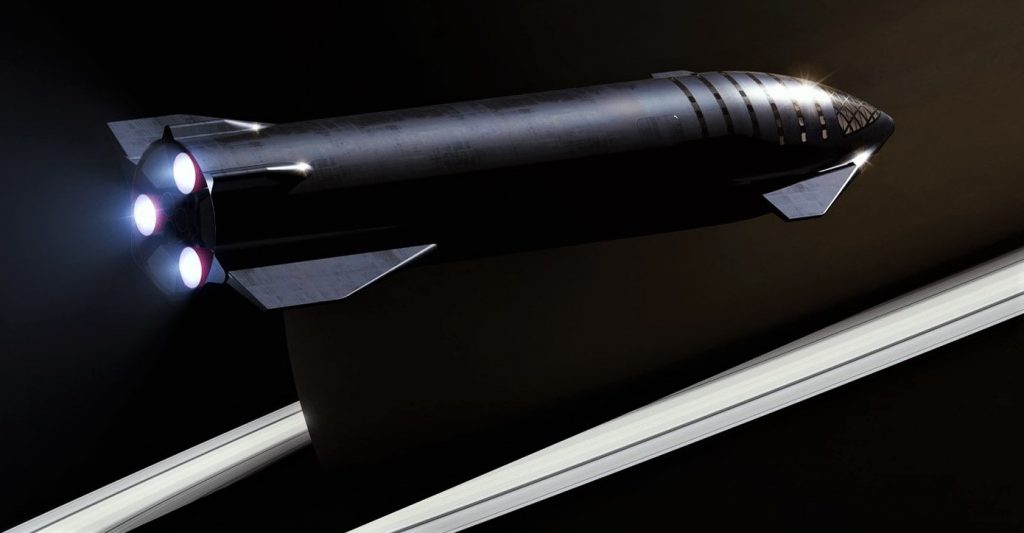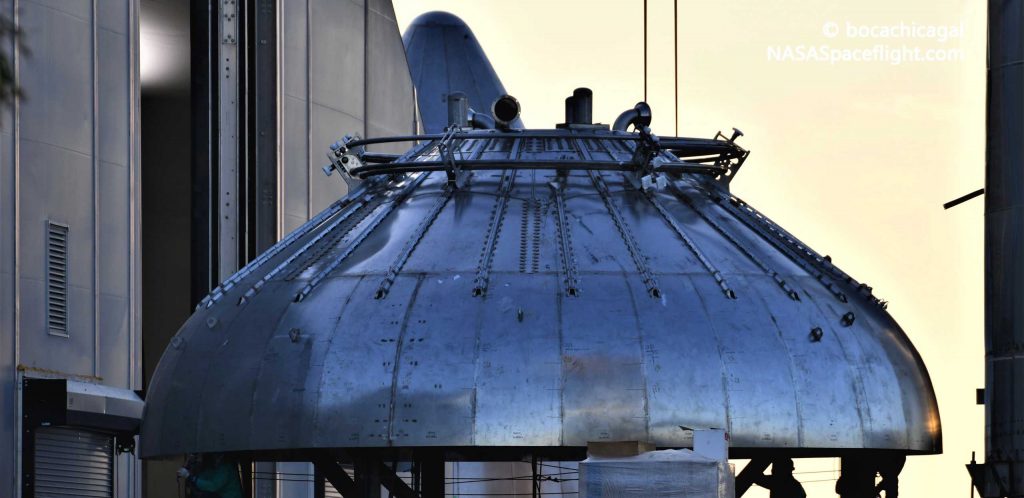

News
SpaceX’s most important Super Heavy booster part makes first appearance
What is arguably the most complex and important part of SpaceX’s Super Heavy booster prototype has made its first appearance at the company’s South Texas Starship factory.
Following in the footsteps of Starship development, Super Heavy has been able to extensively borrow from the many lessons learned over the course of building, testing, flying, and building more Starship prototypes. SpaceX is able to use virtually identical materials, equipment, and techniques to build and assemble both Starship and Super Heavy propellant tank barrels and domes, while both stages will also share an extensive foundation of avionics, plumbing, propulsion, and ground systems, among other things.
In fact, lacking a conical nose, secondary (‘header’) propellant tanks, flaps, a reusable orbital-class heatshield, and vacuum-optimized Raptor engines, Super Heavy is actually substantially simpler than the Starships it will one day launch towards orbit. However, not everything is simpler. Super Heavy will ultimately be the largest and most powerful liquid-fueled rocket stage ever built or tested – power that demands as many as 28 Raptor engines and a thrust structure capable of feeding and withstanding them.
Designing, building, and testing such a thrust structure is arguably one of – if not the – most challenging engineering hurdle standing between SpaceX and its aspirational Super Heavy design. It’s the first of those Super Heavy-specific thrust structures – in the form of a tank dome – that was spotted at SpaceX’s Boca Chica, Texas Starship factory on January 25th, roughly six weeks after its main component was spotted.
Unlike Starship, which relies on a small central ‘thrust puck’ fit for three sea-level-optimized Raptor engines and plans for three larger vacuum-optimized engines that will attach to the side of its hull, Super Heavy’s current design iteration features as many as 28 sea-level Raptors. Aside from CEO Elon Musk revealing that Super Heavy would have a central cluster of eight engines, the precise configuration has been a mystery.

The reality, as recently captured in photos above by NASASpaceflight photographers and contributors Mary (BocaChicaGal) and Jack Beyer, appears to be a much larger donut-shaped ring with space for eight gimballing Raptor engines. The remaining 20 Raptor engines would then be installed – possible mounted to the skirt, the thrust dome, or both – in the space left between the thrust donut and Super Heavy’s skirt.
Either way, the structures behind the two rings of engines will have to withstand at least 6600 metric tons (14.5 million lbf) of thrust at liftoff – approximately twice the thrust of Saturn V and Soviet N-1 rockets and more than three times the thrust of SpaceX’s own Falcon Heavy. Holding eight Raptors, the donut structure and dome recently pictured for the first time will also have to singlehandedly stand up to 1600 tons (3.5 million lbf; two Falcon 9s’ worth) of thrust while gravity, acceleration, and some 2500 tons of supercooled liquid oxygen push in the opposite direction.



In simpler terms, the business end of Super Heavy poses an extraordinarily difficult challenge and SpaceX has already built the first true-to-life prototype, with future iterations likely close on its heels. Much like Starship, if/when prototype booster number one (BN1) passes basic pressure and cryogenic proof tests, SpaceX will likely focus the rest of Super Heavy’s first test campaign on stressing the rocket’s unproven thrust structure to its design limits.
Like Starship, SpaceX will likely try to begin with nonexplosive methods, perhaps using a similar – but far larger – series of hydraulic rams to less riskily simulate the thrust of 8-28 Raptor engines. A steel structure spotted on a recent aerial overflight of SpaceX’s Starship factory might even fit the bill for such a structure, though only time will tell.
Based on an apparent acceleration of Super Heavy assembly work that may have started last week, as well as the crucial appearance of the last missing puzzle piece in the form of BN1’s thrust dome, the first booster could be completed and ready for testing sooner than later.

Elon Musk
Tesla’s Elon Musk: 10 billion miles needed for safe Unsupervised FSD
As per the CEO, roughly 10 billion miles of training data are required due to reality’s “super long tail of complexity.”

Tesla CEO Elon Musk has provided an updated estimate for the training data needed to achieve truly safe unsupervised Full Self-Driving (FSD).
As per the CEO, roughly 10 billion miles of training data are required due to reality’s “super long tail of complexity.”
10 billion miles of training data
Musk comment came as a reply to Apple and Rivian alum Paul Beisel, who posted an analysis on X about the gap between tech demonstrations and real-world products. In his post, Beisel highlighted Tesla’s data-driven lead in autonomy, and he also argued that it would not be easy for rivals to become a legitimate competitor to FSD quickly.
“The notion that someone can ‘catch up’ to this problem primarily through simulation and limited on-road exposure strikes me as deeply naive. This is not a demo problem. It is a scale, data, and iteration problem— and Tesla is already far, far down that road while others are just getting started,” Beisel wrote.
Musk responded to Beisel’s post, stating that “Roughly 10 billion miles of training data is needed to achieve safe unsupervised self-driving. Reality has a super long tail of complexity.” This is quite interesting considering that in his Master Plan Part Deux, Elon Musk estimated that worldwide regulatory approval for autonomous driving would require around 6 billion miles.
FSD’s total training miles
As 2025 came to a close, Tesla community members observed that FSD was already nearing 7 billion miles driven, with over 2.5 billion miles being from inner city roads. The 7-billion-mile mark was passed just a few days later. This suggests that Tesla is likely the company today with the most training data for its autonomous driving program.
The difficulties of achieving autonomy were referenced by Elon Musk recently, when he commented on Nvidia’s Alpamayo program. As per Musk, “they will find that it’s easy to get to 99% and then super hard to solve the long tail of the distribution.” These sentiments were echoed by Tesla VP for AI software Ashok Elluswamy, who also noted on X that “the long tail is sooo long, that most people can’t grasp it.”
News
Tesla earns top honors at MotorTrend’s SDV Innovator Awards
MotorTrend’s SDV Awards were presented during CES 2026 in Las Vegas.

Tesla emerged as one of the most recognized automakers at MotorTrend’s 2026 Software-Defined Vehicle (SDV) Innovator Awards.
As could be seen in a press release from the publication, two key Tesla employees were honored for their work on AI, autonomy, and vehicle software. MotorTrend’s SDV Awards were presented during CES 2026 in Las Vegas.
Tesla leaders and engineers recognized
The fourth annual SDV Innovator Awards celebrate pioneers and experts who are pushing the automotive industry deeper into software-driven development. Among the most notable honorees for this year was Ashok Elluswamy, Tesla’s Vice President of AI Software, who received a Pioneer Award for his role in advancing artificial intelligence and autonomy across the company’s vehicle lineup.
Tesla also secured recognition in the Expert category, with Lawson Fulton, a staff Autopilot machine learning engineer, honored for his contributions to Tesla’s driver-assistance and autonomous systems.
Tesla’s software-first strategy
While automakers like General Motors, Ford, and Rivian also received recognition, Tesla’s multiple awards stood out given the company’s outsized role in popularizing software-defined vehicles over the past decade. From frequent OTA updates to its data-driven approach to autonomy, Tesla has consistently treated vehicles as evolving software platforms rather than static products.
This has made Tesla’s vehicles very unique in their respective sectors, as they are arguably the only cars that objectively get better over time. This is especially true for vehicles that are loaded with the company’s Full Self-Driving system, which are getting progressively more intelligent and autonomous over time. The majority of Tesla’s updates to its vehicles are free as well, which is very much appreciated by customers worldwide.
Elon Musk
Judge clears path for Elon Musk’s OpenAI lawsuit to go before a jury
The decision maintains Musk’s claims that OpenAI’s shift toward a for-profit structure violated early assurances made to him as a co-founder.

A U.S. judge has ruled that Elon Musk’s lawsuit accusing OpenAI of abandoning its founding nonprofit mission can proceed to a jury trial.
The decision maintains Musk’s claims that OpenAI’s shift toward a for-profit structure violated early assurances made to him as a co-founder. These claims are directly opposed by OpenAI.
Judge says disputed facts warrant a trial
At a hearing in Oakland, U.S. District Judge Yvonne Gonzalez Rogers stated that there was “plenty of evidence” suggesting that OpenAI leaders had promised that the organization’s original nonprofit structure would be maintained. She ruled that those disputed facts should be evaluated by a jury at a trial in March rather than decided by the court at this stage, as noted in a Reuters report.
Musk helped co-found OpenAI in 2015 but left the organization in 2018. In his lawsuit, he argued that he contributed roughly $38 million, or about 60% of OpenAI’s early funding, based on assurances that the company would remain a nonprofit dedicated to the public benefit. He is seeking unspecified monetary damages tied to what he describes as “ill-gotten gains.”
OpenAI, however, has repeatedly rejected Musk’s allegations. The company has stated that Musk’s claims were baseless and part of a pattern of harassment.
Rivalries and Microsoft ties
The case unfolds against the backdrop of intensifying competition in generative artificial intelligence. Musk now runs xAI, whose Grok chatbot competes directly with OpenAI’s flagship ChatGPT. OpenAI has argued that Musk is a frustrated commercial rival who is simply attempting to slow down a market leader.
The lawsuit also names Microsoft as a defendant, citing its multibillion-dollar partnerships with OpenAI. Microsoft has urged the court to dismiss the claims against it, arguing there is no evidence it aided or abetted any alleged misconduct. Lawyers for OpenAI have also pushed for the case to be thrown out, claiming that Musk failed to show sufficient factual basis for claims such as fraud and breach of contract.
Judge Gonzalez Rogers, however, declined to end the case at this stage, noting that a jury would also need to consider whether Musk filed the lawsuit within the applicable statute of limitations. Still, the dispute between Elon Musk and OpenAI is now headed for a high-profile jury trial in the coming months.








